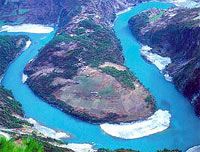 Two ancient mausoleums from the Ming Dynasty (1368-1644) and an area with abundant nature reserves in China were named World Heritage sites this week at the 27th session of UNESCO's World Heritage Committee, which was held in Paris.
Two ancient mausoleums from the Ming Dynasty (1368-1644) and an area with abundant nature reserves in China were named World Heritage sites this week at the 27th session of UNESCO's World Heritage Committee, which was held in Paris.
With the addition, China now boasts 29 sites on the World Heritage List.
The imperial "Xiaoling Mausoleum" in Nanjing, capital of east China's Jiangsu Province, buried the first emperor of the Ming dynasty. It is the first site on the World Heritage List for this ancient city, which served as capital of six dynasties.
Emperor Zhu Yuanzhang and his empress were buried in an underground palace in a round hillock with a diameter of 400 meters.
To date, the city government has spent more than three million yuan (US$366,000) protecting the walls and patching the cracks caused by the sinking of the ground.
The architecture of the Xiaoling Mausoleum had a great impact on subsequent emperors' tombs in the Ming and Qing dynasties, according to Yi Zhiqiang, official with the city's bureau of cultural relics.
Another showcase of China's funeral architecture and culture from centuries ago is the Ming Tombs of 13 Ming emperors and 23 empresses built outside Beijing from the 15th to the 17th centuries.
The 40-square-km mausoleum is China's best-protected tomb group, said Cao Pengcheng, head of the Ming Tombs Office of the Changping District of Beijing.
The municipal government has spent about 170 million yuan since2000 to restore the original magnificence.
Some 400 million yuan will be spent in repairing seven time-worn tombs by 2008, said Nie Youyi, deputy head of the office.
Along with two groups of Ming tombs put on the list of the cultural heritage list, the World Heritage Committee now counts the area of the confluence of three major rivers in southwest China's Yunnan Province on the list of natural heritage.
The area where the Nujiang, Lancang and Jinsha rivers meet, covers about 41,000 square kilometers in Yunnan Province and stretches to the south of the Qinghai-Tibet Plateau. It is famous for its peculiar physiognomy and biological diversity.
The second largest heritage site in the world, the tri-river area is composed of nine nature reserves and 10 scenic spots. At the shortest distance, the Jinsha and the Nujiang rivers are only 66.3 meters apart, and the Nujiang and the Lancang are separated by 18.6 kilometers.
Ancient forests, snow-covered mountains and hundreds of lakes are spread throughout the area, which has 118 mountains above the altitude of 5,000 meters.
Covering only 0.4 percent of China's territory, the area has over 20 percent of the country's national advanced botanical species and 25 percent of animal species. At present, 34 plant species and 77 animal species living in the area are under state protection.
The central and provincial governments have launched several projects over the past 20 years for preventing soil erosion and protecting the forests and wild animals.
A total of 24 new cultural and natural sites all over the world were put on the list by the 27th session of UNESCO committee, held from June 30 to July 5.
To date, 754 sites have been included on the World Heritage List, including 582 cultural sites, 149 natural sites and 23 that fit both categories.
China's 29 sites on the list include four natural sites, 21 cultural sites and four which are both. The most famous sites include the Great Wall, Mount Taishan, the Mogao Grottoes, the Potala Palace and the Peking Man Site at Zhoukoudian in suburban Beijing.
The meeting has decided Suzhou, a scenic destination in Jiangsu Province, will host the 28th session in 2004.
(Xinhua News Agency July 6, 2003)
|

